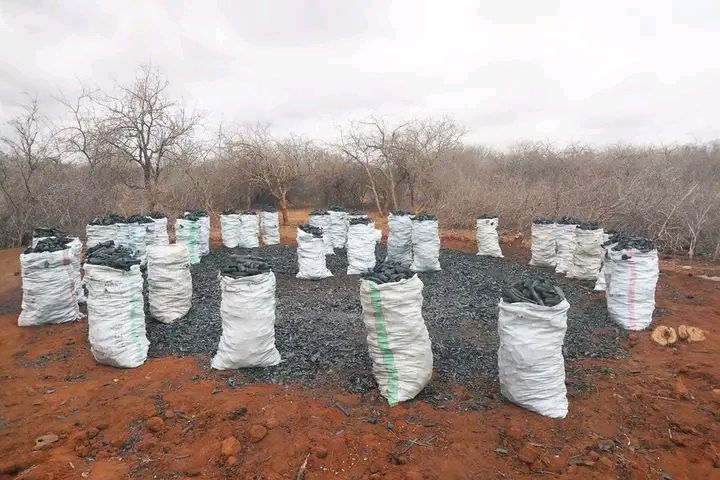
Charcoal burning has become a lucrative source of income and livelihood for many people in Busia. Despite its obvious danger as a health hazard to people and a threat to the environment, more and more people are getting into this business. It has become so common that you can hardly travel a few kilometers without spotting a charcoal kiln by the roadside or deep in someone’s compound.
Sometime last week, a friend of mine came to me looking languid with bloodshot eyes. Concerned, I asked if he was sick or something. You know, there have been Mpox disease cases reported in the country (Mpox Alert: If you have skin rash, fever, headache & body aches, seek urgent medical care. Call 0729471414 or 0732353535 for assistance. Dial *719# for more info). He might have caught it—you never know. He shook his head.
“I didn’t sleep, bro,” he said.
I frowned.
“It is not what you think,” he quickly added irritably. “Actually no one in my household slept.”
“But why?” I asked.
“My neighbor and her charcoal!”
My friend’s immediate neighbor burns charcoal on his small plot twice a week. And mind you, these are not the small mounts we used to prepare back in the day during December holidays to save for Christmas and New Year. The kind of charcoal this neighbor and his partners build are enormous—some as big as manyattas. So you can imagine the kind of smoke emitted from these things and how deadly it can be if the wind decides to send it your way.
According to my friend, one of these charcoal mounts had been built close to his house, and the smoke engulfed his whole home. His three-year-old son cried the whole night, and his wife, a schoolteacher, had to call in sick.
My advice to him was to talk to the neighbor to see if they could relocate the burning elsewhere. If not, he should take the matter to the authorities.
And in recent months, many such projects have been cropping up across the region. Yesterday, on my way to Nambale town to pick up a luggage, I saw another such site on the outskirts of town in a congested residential area. This particular one seemed bigger and more organized: one enormous mount was burning, emitting white smoke that ended up at someone’s doorstep; another was being built by a group of strong, animated young men; women and children were picking ready charcoal and packing it into sacks; and a blue lorry, loaded with wood, waited to unload and later leave with bags of charcoal.
This is no longer just a neighbor’s side hustle. It has become an industry in itself.
Why the rise in charcoal burning?
When I did a post on Biogas Production: Rural Kenya’s Cooking Solution, I highlighted the struggle folks here face in cooking. Traditional firewood is no longer sustainable, and gas is too expensive for most households in the villages. A standard 6kg gas cylinder refill is out of reach for families surviving on casual labor or small-scale farming. For them, charcoal becomes the only affordable alternative.
At the same time, unemployment among the youth is driving many to embrace charcoal production as a quick source of income. With limited opportunities for formal employment, cutting trees and selling charcoal seems like an easy way to make money. Poverty only worsens the problem, as desperate households prioritize short-term survival over long-term sustainability.
There is also high demand for charcoal in urban areas. Boda boda riders, small hotels, and food vendors in towns like Busia, Nambale, and even Kisumu rely heavily on charcoal for cooking. Where there is demand, supply will follow—and this is fueling the increase in charcoal burning across rural Kenya.
Health impacts of charcoal burning
The smoke from charcoal kilns is not just an irritant; it contains dangerous fine particles and toxic gases that cause serious health problems. Prolonged exposure can lead to:
- Respiratory illnesses such as chronic cough, asthma, and bronchitis.
- Eye irritation and long-term vision problems from constant exposure to smoke.
- Fatigue, headaches, and poor sleep, just like what my friend and his family experienced when the smoke engulfed their home.
- Increased vulnerability to infections, especially among children, expectant mothers, and the elderly.
This isn’t just theory. Busia already struggles with respiratory diseases, which are among the most common illnesses reported in the county’s 81 health facilities. The problem is worsened by poor air quality: Busia’s PM2.5 concentration is around 65.3 µg/m³, which is about 13 times higher than the World Health Organization’s safe limit. This means families living near charcoal kilns are breathing in levels of pollution classified as “unhealthy” almost every day.
Across Kenya, the picture is even bleaker: household air pollution kills an estimated 26,000 people annually, and more than one million healthy life years are lost to diseases linked to smoke from charcoal and firewood. Busia is clearly not spared.
Environmental effects of charcoal burning
Charcoal burning is also an enemy of the environment. To produce charcoal, trees must be cut down, and in regions like Busia where forest cover is already low, this accelerates deforestation.
The consequences are dire:
- Loss of biodiversity as animal habitats are destroyed.
- Soil erosion and land degradation from bare land left behind after tree cutting.
- Climate change acceleration since deforestation reduces the earth’s natural ability to absorb carbon dioxide.
- Air pollution, which not only affects households but also contributes to global warming.
Nationally, Kenya loses an estimated 84,000 hectares of forest per year, and degradation costs the country about KES 534 billion annually—nearly 3% of GDP. If unchecked, counties like Busia risk losing more trees and becoming increasingly vulnerable to drought, food insecurity, and water scarcity.
The way forward
Busia, like many other rural regions in Kenya, needs sustainable alternatives. Promoting biogas, energy-efficient stoves, and renewable energy sources can reduce dependence on charcoal. Households that have embraced biogas, for instance, not only save money but also recycle farm waste like cow dung into clean cooking energy.
Authorities must also step in. Illegal charcoal burning should not be ignored simply because it provides income. There must be stronger enforcement of environmental laws, alongside community education on the dangers of uncontrolled deforestation.
But the solution cannot stop at punishment alone. Communities need viable alternatives for both cooking fuel and income generation. Tree planting programs, youth employment initiatives, and affordable renewable energy technologies can create a balance between livelihood and environmental protection.
What can you do?
- Report illegal charcoal burning sites in your community to the local authorities.
- Support clean energy alternatives—whether it’s adopting energy-saving jikos, investing in biogas, or using solar cookers.
- Plant trees to restore lost forest cover and secure the environment for future generations.
- Raise awareness by talking to neighbors and community members about the dangers of charcoal smoke and deforestation.
Because at the end of the day, a clean environment and healthy families are worth far more than a few bags of charcoal. Busia must wake up to this reality before it’s too late.
Also Read: Trees: Africa’s Next Economic Frontier Through Carbon Credits

Disclosure: This banner contains an affiliate link. I may earn a commission if you purchase through it, at no extra cost to you.
